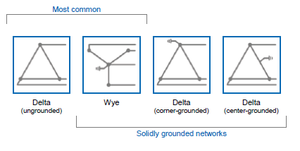News

North American voltage supply networks and load types
North American voltage supply networks and load types
Electrical networks within North America supply power to residential, commercial, and industrial structures. Depending on the amount of power required for a given installation, various voltage configurations can be utilized.
North American voltages
North American commercial installations are typically supplied using either 120/240 V AC split (dual) or 208Y/120 V AC, 3-phase wye networks. Industrial installations within the U.S. commonly use 480Y/277 V AC, 3-phase wye networks. For Canada, the network voltages are increased to 600Y/347 V AC. 3-phase delta networks, which do not offer a line-to-neutral voltage, are also common, most often supplying either 240, 480 or 600 V AC.

Manual motor starters are commonly applied in both industrial and commercial applications. To meet the requirements for North America, they are suitable for use on 1- and 3-phase networks with line-to-line voltages up to 600 V AC.
Three-phase network configurations
North American 3-phase supply networks differ based on the secondary winding of the upstream transformer. The two most common secondary winding styles are wye, which includes three power legs and a neutral, and delta, which includes only three power legs without a neutral connection. These networks can be either grounded or ungrounded.
Solidly grounded wye and ungrounded delta networks are most common in North America.

3JIndustry Specialized Distributor - Buy & Sales Used Products
Email : Sales@3JIndustry.com
- 3J Industry

How its Work : Power Supplies
Introducing Power Supplies
Power is the backbone of any electronic system and the power supply is what feeds the system. Choosing the right supply can be the critical difference between a device working at optimum levels and one that may deliver inconsistent results.
In addition to alternating current (AC) to direct current (DC) power supplies, DC to DC converters are also available. If DC is already available in your system, a DC to DC converter may be the better design choice than AC discussed below.
Direct current power supplies are either unregulated or regulated. Regulated supplies come in several options including linear, switched and battery-based.
AC-DC Conversion Basics
A power supply takes the AC from the wall outlet, converts it to unregulated DC, and reduces the voltage using an input power transformer, typically stepping it down to the voltage required by the load. For safety reasons, the transformer also separates the output power supply from the mains input.
Figure 1, Figure 2, and Figure 3 illustrate the general transformation from AC to DC.
Alternating current takes the form of a sinusoidal wave with the voltage alternating from positive to negative over time.
Figure 1: Alternating Current from Wall Outlet
In the first step of the process, the voltage is rectified using a set of diodes. Rectification transforms the sinusoidal AC. The rectifier converts the sine waves into a series of positive peaks.
Figure 2: Full Wave Rectified
| Once the voltage has been rectified, there is still fluctuation in the waveform—the time between the peaks—that needs to be removed. The rectified AC voltage is then filtered or “smoothed” with a capacitor. The capacitor is typically quite large and creates a reservoir of energy that is applied to the load when the rectified voltage drops. The incoming energy is stored in the capacitor on the rising edge and expended when the voltage falls. This significantly reduces the amount of voltage droop and smooths out the voltage. Increasing the storage capacity of the capacitor generally produces a higher quality power supply. Figure 3 shows the rectified voltage and how the capacitor smooths the droop.  Figure 3: Full Wave Rectified + Capacitor Once the voltage conversion is complete, there is still some variation in output, called ripple. In a regulated power supply, the voltage is then passed through a regulator to create a fixed DC output with less ripple. |
|
Power Supply Comparisons AC power supplies come in two varieties, unregulated and regulated. Unregulated is the most basic type of power supply and does not have the ability to supply consistent voltage to a load, while regulated power supplies do and have many different design options. Linear converters are the least complex but also create the most heat, while switched converters are more intricate and cooler but create more noise. Batteries are typically switched converters. Each has advantages and drawbacks but which to use will be based mostly on the type of application and the conditions under which it will be run. Table 1 illustrates how the types of power supplies are categorized and summarizes many of the pros and cons of each type. |
| UNREGULATED | REGULATED | ||
Pro:
Con:
|
Pro:
Con:
|
||
| LINEAR | SWITCHED | BATTERY | |
Pro:
Con:
|
Pro:
Con:
|
Pro:
Con:
|
|
|
Table 1: Types of Power Supplies |
|||||
|
Unregulated Power Supply Theory
|
3JIndustry Specialized Distributor - Buy & Sales Used Products
Email : Sales@3JIndustry.com
- 3J Industry






